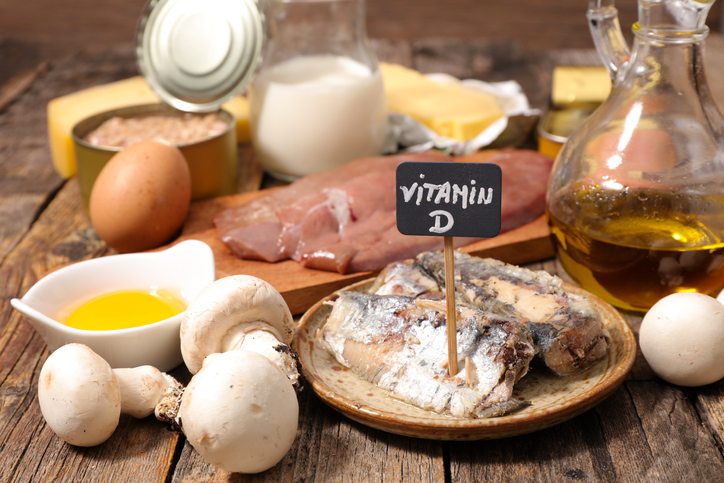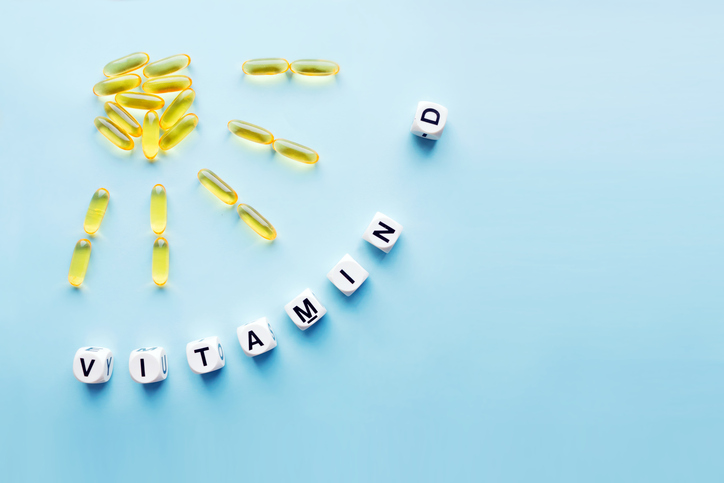- pediatriepropraxi.cz - expert article in pdf about vitamin D and childhood.
- ods.od.nih.gov - Vitamin D
- medicalnewstoday.com - What are the health benefits of vitamin D?
- hsph.harvard.edu - Vitamin D
Vitamin D and its effects. Our health, strong bones or strong immunity?

Yes, vitamin D is needed for bones. But it is also very important for immunity and many other processes. Spring, summer and sun are the main sources. Let's not forget about diet. During the winter months, its natural production in the body is lacking, so it needs to be replaced artificially.
Article content
- What is vitamin D?
- How is it produced?
- What roles does it play in the body?
- The main, but also lesser-known sources of vitamin D
- The required daily allowance
- Why is there not enough of it in our bodies?
- Can we overdose on vitamin D?
- What is the form of checking its current blood level?
- In winter, its level is lowest
It plays an important role in defence or immune reactions. Its deficiency is associated with autoimmune diseases, diabetes, cardiovascular diseases. It plays a major role during pregnancy, in the development of the fetus, newborn or young children.
It is also referred to as the sunshine vitamin.
What is vitamin D, what are its functions in health and what are its effects on health?
What is its source, what are its proper levels and doses?
What is vitamin D?
This vitamin is made up of biologically active substances called calciferols. Our body gets them from sun exposure, either through UVB type sunlight or through food.
We know the basic types of vitamin D:
- ergocalciferol, which is actually vitamin D2, of plant origin.
- cholecalciferol, i.e. D3, of animal origin, produced in human skin
- the other forms are D1, D4 and D5
Although vitamin D is referred to as a vitamin, its tasks and functions go far beyond this term. It is also more appropriately referred to as a hormone.
Vitamin D is a fat-soluble vitamin.
Vitamin C, for example, is soluble in water.
It participates in the regulation of calcium metabolism, stimulates the absorption of various minerals in the intestine. Subsequently, it helps in immune processes. Its deficiency is a risk for the development of autoimmune diseases.
How is it produced?
A significant amount, up to 90% of this vitamin, is produced in the skin.
UVB radiation from the sun acts on the skin. During this process, a certain form of cholesterol is required for synthesis, namely 7-dehydrocholesterol.
Subsequently, in the liver and kidneys, this prohormone is converted into an important form and is referred to as calcitriol (1,25-dihydroxycholecalciferol). In this form, it is biologically active and performs various necessary and important functions in our body.
Sunlight is important in its production, which the sun provides during the warm months.
During autumn and winter its production is limited.
Therefore, it needs to be supplied to the body in another form.
The table gives a brief overview of the formation process
| Vitamin D2 | Vitamin D3 |
| Plant origin | is of animal origin and is produced in the skin |
| 7-dehydrocholesterol + sunlight UVB | |
| UVB wavelength 290-315 nm | |
| so far biologically inactive | |
| pass to the liver | |
| where the enzyme 25-hydroxylase acts | |
| 25-hydroxycholecalciferol is formed 25OHD - calcidiol | |
| only then are they converted in the kidneys | |
| by the enzyme 1-hydroxylase | |
| to the biologically active form | |
| 1,25 hydroxycholecalciferol or also calcitriol | |
What roles does it play in the body?
Calcitriol, converted vitamin D, is a steroid hormone. Its best known role is to regulate the absorption of calcium and phosphate in the intestine. People therefore associate it with bone and, when deficient, with osteoporosis or rickets.
The table below lists the most important spectrum of vitamin D effects and the problems associated with vitamin D deficiency
| Body system | Effect |
| Bones | Affects homeostasis - the balance of calcium and phosphorus levels in the blood and bones |
| mineralization of bone tissue | |
| during pregnancy and intrauterine development of fetal bones | |
| bone growth in newborns and young children | |
| for dental health | |
| long-term deficiency leads to rickets and osteoporosis, i.e. thinning of the bones and the risk of fracture susceptibility, but also, for example, fatigue fractures | |
| Muscles |
in deficiency develops:
|
| Immunity | supports immunity |
| deficiency causes weakened immunity and increased morbidity increased incidence of respiratory illnesses including flu or seasonal colds or other acute infections has been found | |
at low levels, the risk is the development of autoimmune diseases such as:
| |
| |
| Cardiovascular disease | has a preventive effect against cardiovascular diseases such as IHD or hypertension |
| Nervous system |
|
| General and other problems with vitamin D deficiency |
|
| Obesity |
|
Pregnancy and childhood
Proper vitamin D levels are important during pregnancy. Of course, they are also important for the woman. Reduced levels are associated with gestational diabetes or pre-eclampsia.
Are you planning a pregnancy or are you pregnant?
How to recognize pre-eclampsia
The main importance for the baby lies already in the intrauterine development of the fetus.
Vitamin D is responsible for the development of the entire skeleton of the fetus. Insufficient levels during pregnancy can cause the baby to develop asthma, various allergies or autoimmune diseases. It is also important for achieving a normal birth weight of the newborn.
It is also valuable in the production of breast milk. As well as for bone growth and dental health in infants and young children. A commonly known vitamin D deficiency disease in children is rickets.
The effects of vitamin D run throughout the body. As is well known, even those as yet undiscovered functions demonstrate its important need. Where we get it is partly controlled by us.
There are also less popular sources, which we list later in the article.

The main, but also lesser-known sources of vitamin D
Vitamin D3 is produced by the body itself, through the skin and sunlight. Everyone probably knows that it is synthesised when we sunbathe. This is how the body gets up to 90% of the vitamin it needs.
During 30 minutes of sunbathing in the summer sun, the body produces between 10,000 and 12,000 units. In the summer months, the body builds up a supply for 2-4 months.
The best sun is in spring and summer.
During this period, the sun contains the necessary spectrum of rays - UVB radiation.
During the autumn months (especially November) and winter (until February), sunlight is ineffective for vitamin D production.
Vitamin D synthesis is influenced by various factors such as:
- the time of year
- geographical location, northern and southern countries from 40° during winter
- part of the day
- race, skin pigment, darker or thicker skin needs longer to produce the same amount
- the ability of the skin to form vitamin D decreases at older ages, by about 75% over 65
- use of protective creams
- the area of skin exposed to the sun
Read also articles on getting a beautiful tan and how to protect your skin from the sun
We list lesser known sources from which we can get vitamin D
Apart from the sun, vitamin D can also be obtained from other sources. Most of it is contained in fish meat and fish oil.
Eggs are another source, but also dairy products and liver. Plants contain minimal amounts, for example spinach.
Some foods contain it in its natural form. In others it is artificially added.
This process is known as fortification.
It helps to fortify, for example, dairy products or various vegetable fats and spreads.
It is also found naturally in some mushrooms, which contain a form of D2. Mushrooms are low in energy and therefore suitable for diets or vegetarian diets as a kind of substitute for animal products.
With mushrooms, care should be taken with the poisonous ones. The symptoms of mushroom poisoning are described in a magazine article.
The table lists some foods with vitamin D content per 100 grams
| Raw material | Vitamin D content in IU (International Units) per 100 grams |
| Cod liver | 10 000 |
| Sardines | 1500 |
| Salmon | 440 |
| Emmental cheese | 120 |
| Poultry liver | 65 |
| Beef liver | 40 |
| Eggs | 28 |
| White yoghurt | 2,4 |
| Cow's milk | 0,3-54 |
| Breast milk | up to 10 |
| Spinach | 0,2 |
Fortified foods are more abundant in some (especially Nordic) countries. It is also mandated by law.
The most common are dairy products, milk, various yoghurt drinks and vegetable fats or cocoa. Their price is in most cases slightly higher.

The required daily allowance
The correct dose of vitamin D varies depending on age. It is needed already during the growth of the fetus in the womb.
The minimum daily requirement of vitamin D for different ages:
- Infancy to 1 year of age = 100 IU
- children over 1 year = 600 IU
- adults up to 70 years = 1500-2000 IU
- over 70 years = minimum 800 IU, but the same dose as in adulthood is appropriate
- pregnant and lactating women = minimum 600, but 1500 IU is best
In various articles you will find vitamin D values given in µg. The conversion is as follows:
1 µg = 40 IU of vitamin D
Why is there not enough of it in our bodies?
How much vitamin D we have in our blood depends on several internal and external factors. Internal factors include, for example, genetic influences or obesity.
In newborns, it is the level in the mother's blood during pregnancy, in infants in breast milk during breastfeeding. In young children, nutritional supplements such as drops containing it affect the lack of supply.
In addition, low levels in the diet also have a negative impact. The most significant component is lack of sunlight.
The lack of sun is caused by a sedentary lifestyle, but also by the unnecessary fear of skin cancer. Melanoma is the bogeyman of our time, but we cannot avoid the sun completely.
It could be said that the main cause is a poor lifestyle. Most of the time spent working sedentarily, indoors, playing on the computer or watching TV, for children and adults alike, takes its toll.
In addition, lower intake of foods such as fish and fish oil contribute to vitamin D deficiency. In addition to vitamin D, they also contain healthy unsaturated fatty acids.
Interesting fact: About fatty acids
The elderly are most often at risk of deficiency, especially those placed in social care facilities, partially or completely immobile. But also diabetics or people recovering from illness or injury.
Similarly, people who are obese. Adipose tissue takes up vitamin D, causing a reduction in blood levels.
Normal blood levels of vitamin D
When assessing blood levels of vitamin D, a level above 75 nmol per litre of blood is considered normal. It is reported to have significant positive effects at levels above 100 nmol per litre.
Can we overdose on vitamin D?
Vitamin D is fat-soluble. This leads to the possibility of intoxication, hypervitaminosis or overdose. Negative effects of excess vitamin D in the blood are reported at long-term levels above 250 nmol/l.
But.
You don't have to worry about staying out in the sun. There is no such thing as a vitamin D overdose from the sun.
The only form of excess can be caused by artificial and excessive supply to the body. An example would be a combination of sunbathing, intake of foods high in and simultaneous consumption of dietary supplements, tablets high in the vitamin.
Long-term overuse of vitamin D is over 25 micrograms (1000 IU per day) in children and over 50 micrograms (2000 IU per day) in adults.
What are the manifestations of hypervitaminosis, i.e. excess vitamin D?
Prolonged elevated vitamin D levels cause calcium to be broken down from the bones and to be elevated in the blood. This results in calcium deposition in the soft tissues.
For example, calcification of blood vessels, damage to the heart or kidneys.
Dietary supplement overdoses are more common in infants when excessive doses are given for a prolonged period of time.
In young children, overdose manifests as muscle weakness, flaccidity, increased irritability, excessive thirst and frequent urination, but also with vomiting.
This gradually causes dehydration or constipation.
Examples of overdose symptoms in adults include:
- Nausea
- vomiting
- lack of appetite
- excessive thirst
- weakness
- fatigue
- nervousness
- constipation
- dehydration
- weight loss
Let's look at all the summer problems together:
Our health in summer - sun, heat, injuries and illness
What is the form of checking its current blood level?
There is no screening of vitamin D levels in the population nowadays. Too bad. It is ordered by a general practitioner for differential diagnosis or perhaps by an immunologist for an immune disorder.
Self-referral and non-medical testing is usually self-funded. It's done in the biochemistry department.
In winter, its level is lowest
The period from autumn to the end of winter is characterised by a reduced production of vitamin D in the skin. As a consequence, there is also a lack of UVB radiation. The need for supplementation with food or nutritional supplements increases.

Video o vitamíne D
Interesting resources
Related










